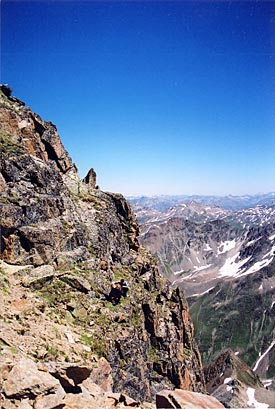Press release, November 30th, 2007
Mountain summits in the Alps becoming increasingly similar
St Moritz/Leipzig. Alpine summit vegetation will become increasingly homogenized as a result of climate change, say researchers from the University of Bayreuth and the Helmholtz Centre for Environmental Research writing in the international Journal of Vegetation Science. The biologists assessed data on the composition and species numbers of plants on the summits of seven mountains measuring over 3000 metres in the Bernina range in Switzerland over a period of almost one hundred years. They noticed that as a result of climate change, an upward shift of flora is taking place. This is increasing the number of species on the mountain summits studied, but also leading to an increasing homogenization of the species composition of Alpine summit vegetation. This means that species diversity within individual areas (‘alpha diversity’) is increasing, but that species diversity across ecosystems (‘beta diversity’) is declining.
Seen generally, biodiversity can decline for two main reasons: through the disappearance of species, or when specialised species are replaced by generalists. The resulting homogenization can lead to a reduction in regional biodiversity. Until now, the question of homogenization has, however, primarily been discussed in connection with the impacts of invasive species, and less in the context of climate change. The evaluation of the data from the Bernina range now puts this debate in a new light. For their study, the two researchers analysed data from their colleague Gian-Reto Walther, who investigated the top ten metres of these summits in detail in 2003 and made notes of all the plants. They compared these records with surveys from the years 1907 and 1985. On average, the number of plant species rose from 10 to 28 species per summit. The increasing temperatures has evidently brought about a proper ‘summit meeting’.
More and more species are now forced to share the summits. At the last count in 2003, however, no species were found to have
disappeared since 1907. By contrast, the differences between the summits declined significantly over the same period. Today the summits
of the Minor range are not only more similar to each other, they are also more similar to the neighbouring Languard range than before,
despite the fact that they are separated from each other within the Bernina Alps by the Val da Fain. "This is a clear sign of the early
stages of homogenization," says Gerald Jurasinski, a biogeographer from the University of Bayreuth. "We suspect that the accessibility
and popularity of these summits among climbers is playing a role here – after all, seeds can also be carried on people’s clothes and
shoes. But unfortunately there is not yet any data for this," remarks Jürgen Kreyling of the Helmholtz Centre for Environmental Research -
UFZ. The two researchers hope their work will draw attention to the fact that biodiversity means more than species richness.
The composition of the species spectrum, beta diversity and functional diversity also play an important role in functioning ecosystems.
The University of Bayreuth is carrying out intensive research into this topic in collaboration with the UFZ, and this is also
reflected in its courses, e.g. the Masters degree in Global Change Ecology, which forms part of the Bavarian Elite programme.
Tilo Arnhold
Publication:
Jurasinski, Gerald & Kreyling, Jürgen (2007):
Upward shift of alpine plants increases floristic similarity of mountain summits. Journal of Vegetation Science 18:711-718.
doi: 10.3170/2007-8-18341
Links:
More information:
Dr Gerald Jurasinski
Landscape Ecology and Site Science, University of Rostock
www.auf.uni-rostock.de/loe/mitarbeiter.asp
phone +49 381 498-3225
und
Jürgen Kreyling
Helmholtz Centre for Environmental Research - UFZ
phone +49 341 235-2100
Jürgen Kreyling
or
Helmholtz Centre for Environmental Research - UFZ
Press office
Tilo Arnhold / Doris Böhme
Telefon: +49 (0)341 235 2278
presse@ufz.de
The Helmholtz Centre for Environmental Research – UFZ was established in 1991 and has about 830 employees in Leipzig, Halle/S. and Magdeburg. They study the complex interactions between humans and the environment in cultivated and damaged landscapes. The scientists develop concepts and processes to help secure the natural foundations of human life for future generations.
The Helmholtz Association contributes to solving major challenges facing society, science and the economy with top scientific achievements in six research areas: Energy, Earth and Environment, Health, Key Technologies, Structure of Matter, Transport and Space. With 25,700 employees in 15 research centres and an annual budget of approximately 2.3 billion euro, the Helmholtz Association is Germany's largest scientific organisation. Its work follows in the tradition of the great natural scientist Hermann von Helmholtz (1821-1894).

